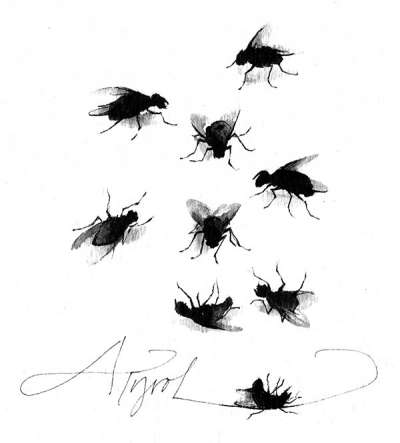
So here’s my movie concept: during a laboratory accident, a scientist exchanges his DNA with a fly. Over the next few weeks, our hero slowly shrinks in size and transforms into an insect with black spiky body hair, maroon eyes, and translucent, buzzing wings.
What distinguishes this movie from previous versions of “The Fly” is that this time, the scientist swaps his genes with a cluster fly. Instead of developing super-fast reflexes, he becomes clumsy and lethargic. Instead of rampaging through a city terrorizing people, he alternates his time between crashing against the window and lying upside-down on the floor, twitching. The crisis comes when his irritated girlfriend picks him up with a tissue and tosses him outside. He soars into the clear blue winter sky…but then his wings freeze. The final image: a tiny crater in the snow.
This time of year, cluster flies begin to show up in our homes and outbuildings. They materialize out of nowhere, crawl on the walls, and drive us to distraction by hurling themselves against windows. They’re annoying, but in fairness, their sins as pests are mild; they don’t bite, don’t sting, and despite some rumors, they aren’t vectors for swine flu or other dread diseases. They do fall in coffee mugs, which is hard to forgive.
Until relatively recently, the cluster fly was believed to be one species, Pollenia rudis. In fact, “the” cluster fly, isn’t. In eastern North America, we are blessed with at least six species. Physical differences are slight, involving variations in “anterodorsal tibial setal sockets” and other minutiae. Life cycle differences – where they lay their eggs, what they eat, which flavor coffee they prefer for bathing – are not well documented. So, for example, it may be that not all cluster fly species invade human structures.
With that disclaimer, here’s a rough biography of these unwelcome winter companions. From early spring through autumn, the flies are frequent, little-noticed visitors to gardens and meadows. They’re common pollinators; for example, in one study, researchers identified them among the many flying insects that can aid in the reproduction of strawberry plants.
During the warm months, they cycle through several generations. Females deposit their eggs on the ground. Larvae burrow downward, taking advantage of natural openings into the earth such as loose soil around plants and worm tunnels (though it doesn’t take much to impede them; worm castings in tunnels can be effective blocks).
Earthworms appear to be their only prey. If a larva encounters a worm (and if it’s the right species; research suggests that not just any worm will do), events proceed in typically gruesome parasitoid fashion. The larva tunnels into its prey’s living flesh, gaining both a home and a meal. More than one larva may inhabit the same host. Eventually the larva pupates, then emerges from the ground.
And so life buzzes merrily along until cold weather sets in. The flies respond by seeking out shelter where they can conserve energy in a torpid state. This shelter can be a beetle tunnel or animal burrow. It can also be a crevice in a barn or house; cluster flies are notorious for finding their way into tiny openings. A sunny façade on an old building, with wiggle room between the clapboards, is an attractive setup for a home invasion.
Or for a church invasion. Consider this excerpt from Oldroyd’s The Natural History of Flies:
In churches, where the heating often operates only at weekends, the flies may become active in a sluggish sort of way, and fall squirming [onto] the hair and hymnbooks of the worshippers below.
With incidents like these, it’s easy to feel as if cluster flies seek us out for special torment. Yet many of the flies that invade our structures never become nuisances. They live peaceably as stowaways in our attics and other cool spaces, then depart again in the spring.
The flies we encounter are the doubly unfortunate ones; hatched into a hardship generation, they’ve had the further bad luck of wandering into heated spaces where they rouse out of their winter torpor to waste energy, desiccate, and most often, slowly die (or meet more violent ends: bored cat, vacuum ex machina).
Although they’ll never get the earthworm vote, maybe understanding the plight of these flies can make them a little more tolerable. Maybe. If nothing else, it’s something to contemplate next time one shows up in your coffee.


Discussion *